
Okhotsk Chapter
of the Wild Bird Society of Japan
![Siberian Rubythroat / Nogoma [photo: A.S.] nogoma](images/120624nogoma130h.jpg)
| Home | Events | Reports | Sightings | Checklist | Bird Guide |
| Birding Info | J Bird Names | References | Links | About Us | Contact Us |
| 2013 Event Report Archives | 2013 Seabirding Archives | Back to Archives Index | |||
To Tsubetsu Event (30 June) To Wakka Event (7 July) To Swan Park Event (3 Nov.)
It has been unseasonably cold this spring after an unusually severe winter of snow. Today was the end of the holiday-studded Golden Week in Japan, a time when the rest of the country enjoyed normal spring weather, while for us it brought what felt like the first day of spring. We were truly fortunate. It was a perfect day to see what the birds were up to, and also a time when the Asian White Skunk Cabbage (Mizu-bashou; Lysichiton camtschatcensis) was in full bloom. I was particularly hoping to see displays of Latham's Snipes that normally occur here at this time of year. They winter in Australia and return to this area and other spots in Hokkaido to breed. The energy they still have is remarkable after migrating thousands of kilometers to get here.
.jpg) |
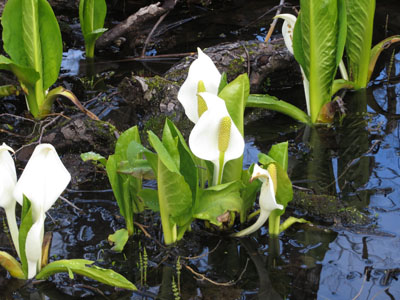 |
| Mizu-bashou are everywhere. We walk along the rather wet path for about a kilometer before we see Abashiri Lake. The path continues for about 5 kilometers along the Yobito Peninsula that juts out into the lake. | Close-up. The cold weather allowed the blossoms to stay out longer than usual this year. |
.jpg) |
.jpg) |
| After arriving at the lake, we spot numerous varieties of ducks, a few Gray Herons in breeding plummage, a White-tailed Sea-Eagle, and this pair of Red-breasted Mergansers (Umi-aisa). The complete list of birds we either saw or heard this day is below. (Yes, Latham's Snipe is among them! The displays were exciting as usual.) | |
| This bird has a black face but it is not a Black-faced Bunting (Aoji); it is an Oriental Greenfinch (Kawara-hiwa). Unlike the Black-faced Bunting, it is here year-round, but it was nevertheless a treat to see it against the beautiful blue sky. | |
.jpg) |
Adonis ramosa (Fukujuusou). A member of our group explained that the particular plants we saw along the path were of the Kitami variety (Kitami Fukujuusou) which has only one flower per shoot above the ground. Kitami is a city about 50 kilometers inland from here. |
Today's list: Falcated Duck (Yoshi-gamo), Mallard (Ma-gamo), Teal (Ko-gamo), Smew (Miko-aisa), Red-breasted Merganser (Umi-aisa), Little Grebe (Kaitsuburi), Oriental Turtle Dove (Kiji-bato), Gray Heron (Ao-sagi), Latham's Snipe (Ooji-shigi), Black-headed Gull (Yuri-kamome), Black Kite (Tobi), White-tailed Eagle (Ojiro-washi), Eurasian Sparrowhawk (Hai-taka), Common Kingfisher (Kawa-semi), Japanese Pygmy Woodpecker (Ko-gera), Lesser Spotted Woodpecker (Ko-aka-gera), White-backed Woodpecker (Oo-aka-gera), Great Spotted Woodpecker (Aka-gera), Eurasian Jay (Kakesu), Carrion Crow (Hashiboso-garasu), Large-billed Crow (Hashibuto-garasu), Marsh Tit (Hashibuto-gara), Varied Tit (Yama-gara), Japanese Tit (Shijuu-gara), Eurasian Skylark (Hibari), Brown-eared Bulbul (Hiyodori), Japanese Bush Warbler (Uguisu), Asian Stubtail (Yabusame), Long-tailed Tit ssp (Shima Enaga), Eurasian Nuthatch (Gojuu-kara), Eurasian Treecreeper (Kibashiri), White-cheeked Starling (Mukudori), Russet Sparrow (Nyuunai-suzume), White Wagtail (Haku-sekirei), Oriental Greenfinch (Kawara-hiwa), Long-tailed Rosefinch (Beni-mashiko), Hawfinch (Shime), Black-faced Bunting (Aoji) [38 species]
It was a brilliant clear Sunday morning, warm outside but refreshingly cool inside the forest, and the Japanese Primrose was near full bloom along the stream. One of the first calls we heard as we gathered at the entrance to the trail was that of the Eurasian Wren, and in the blue sky high above us a pair of White-throated Needletails flew and glided in wide circles.
 |
 |
| One of a pair of White-throated Needletails (Hario-amatsubame; Hirundapus caudacutus) |
A few of the total of around 25 of us along the boardwalk in the forest filled with flowering Japanese Primroses (Kurin-sou; Primula japonica) and the soothing sound of the stream |
 |
|
 |
I would not be surprised if this was the same Eurasian Wren (Misosazai; Troglodytes troglodytes) that we heard before we entered the trail. It stayed in this spot and sang for at least 10 minutes while we watched. The surroundings were very lush and beautiful. (Photo at left is a detail of the one above, unfortunately not well focused.) |
 |
 |
| This Eastern Crowned Warbler (Sendai-mushikui; Phylloscopus coronatus) was singing in a deciduous tree at a slightly higher elevation from the stream. We also heard but did not see a Japanese Bush Warbler (Uguisu; Cettia diphone), ubiquitous in the mountains of Hokkaido during spring and summer. (I had to apply brightness in this photo to make the bird more visible.) | Further up the mountain trail, we reached a small wooden observatory with views of surrounding mountains and the valley below. The building below is the Mori Tsubetsu Hotel where we started our walk. More information about the hotel in Engish is available here. |
Today's list: Japanese Green Pigeon (Ao-bato), Oriental Cuckoo (Tsutsudori), White-breasted Needletail (Hario-amatsubame), Great Spotted Woodpecker (Aka-gera), White-backed Woodpecker (Oo-aka-gera), Black Woodpecker (Kuma-gera), Large-billed Crow (Hashibuto-garasu), Marsh Tit (Hashibuto-gara), Brown-eared Bulbul (Hiyodori), Japanese Bush Warbler (Uguisu), Eastern Crown Warbler (Sendai-mushikui), Eurasian Nuthatch (Gojuu-kara), Eurasian Wren (Misosazai), Brown-headed Thrush (Akahara), Japanese Robin (Komadori), Siberian Blue Robin (Ko-ruri), Grey Wagtail (Ki-sekirei), Black-faced Bunting (Aoji) [18 species]
Another beautiful Sunday morning, rather hot this time, requiring protection against the sun. We gathered in the parking lot of the Wakka Nature Center, a few kilometers north of Tokoro, and the very first sound to reach our ears as we emerged from our cars was the remarkable repertoire of a Black-browed Reed Warbler in a slightly reedy spot by the Nature Center. We walked very leisurely for two hours along dirt and paved paths up to the shore of the Sea of Okhotsk and back to the Center.
 |
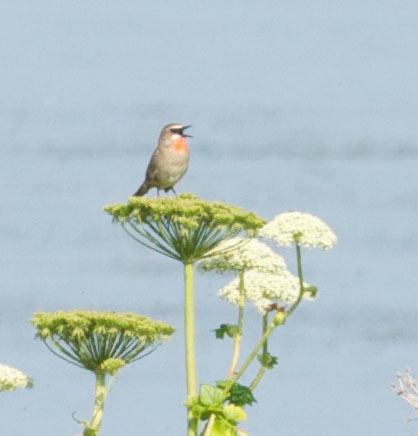 |
| Our welcoming committee: The Black-browed Reed Warbler above (Ko-yoshikiri; Acrocephalus bistrigiceps) who sang here all morning and maybe all day as well, and a Siberian Rubythroat (No-goma; Luscinia calliope) at the right with the waters of Lake Saroma in the background. | |
 |
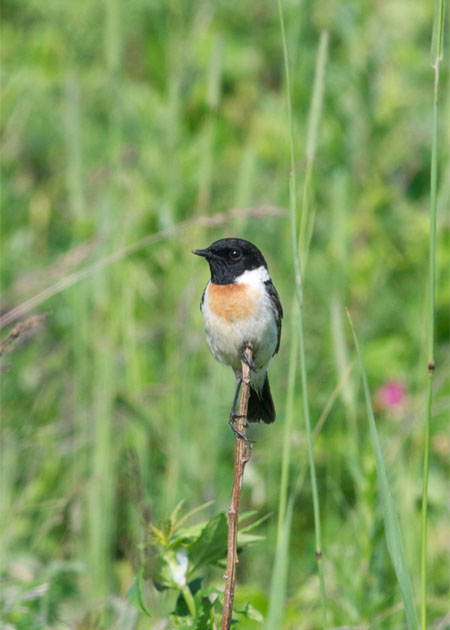 |
| A pair of Siberian Stonechats (No-bitaki; Saxicola maurus* stejnegeri) that I encountered at around 7:20 a.m. along a dirt path. It seemed I was getting too close to their nest, as they became vocally agitated. The female would not go to the nest with her grasshopper meal until the perceived threat receded, so I withdrew from the area! (*Some sources give Saxicola torquatus stejnegeri.) |
|
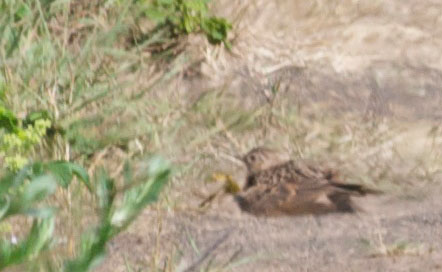 |
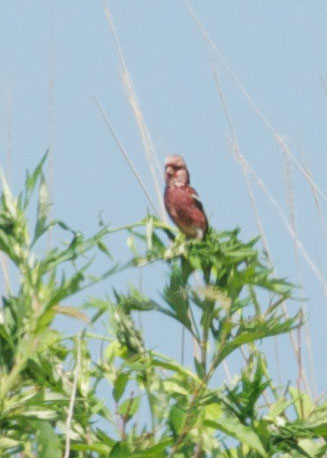 |
| Above: A Eurasian Skylark (Hibari; Alauda arvensis) takes a bath in the dust along the path ahead of us. Right: On the way back from the Sea of Okhotsk shore (where there was only a single cormorant on a distant buoy), we encounter a pair of Long-tailed Rosefinch (Beni-mashiko; Uragus sibiricus sanguinolentus) of which this is the male. No photo: Another common bird here was the Common Reed Bunting (Oo-jurin; Emberiza schoeniclus). |
|
 |
|
The Wakka Nature Center is open from late April to late October. Open hours are 8:00 - 17:00 except for June, July, August when it is open 8:00 - 18:00. The nearest hotel, even in walking distance, is the 4.5-star Lake Saroma Tsuruga Resort that also has a restaurant, shop, and a hot spring that you can use even if you do not stay there. Further information in English about the hotel is here. Other shops are in the area, too, as is the "Tokoro Historical Ruins Forest" located across the street from the hotel. More information about the ruins and small museum there can be found by doing a search for "Tokoro Okhotsk Culture". If you are interested in Okhotsk Culture, you might also want to visit the new Moyoro Shell Mound Museum in Abashiri that opened in May 2013.
Today's list: Oriental Turtle Dove (Kiji-bato), Great Cormorant (Kawa-u), Gray Heron (Ao-sagi), Common Cuckoo (Kakkou), Black-tailed Gull (Umineko), Black Kite (Tobi), Eurasian Wryneck (Arisui), Large-billed Crow (Hashibuto-garasu), Eurasian Skylark (Hibari), Brown-eared Bulbul (Hiyodori), Lanceolated Warbler (Makino-sennyuu), Middendorff's Grasshopper-Warbler (Shima-sennyuu), Black-browed Reed Warbler (Ko-yoshikiri), White-cheeked Starling (Mukudori) [a flock of around 50 young birds flying overhead], White Wagtail (Haku-sekirei), Oriental Greenfinch (Kawara-hiwa), Long-tailed Rosefinch (Beni-mashiko), Black-faced Bunting (Aoji), Siberian Rubythroat (No-goma), Siberian Stonechat (No-bitaki), Common Reed Bunting (Oo-jurin), Feral Pigeon (Kawara-bato/Do-bato) [22 species]
It looked like it would rain but we went anyway. Birds do not care about the rain; why should humans. As it turned out, the rain was no more than sporadic. We focused on the birds.
Whooper Swans come to this area from their breeding grounds in Siberia around the end of October each year. Some stay to winter here and others continue further south to other parts of Japan. Most parents come with offspring, still in gray feathers but the same size as adults. Until two years ago, feeding swans and other wild birds such as Pintails and Mallards that would take the items (white bread crusts sold nearby) was allowed, but the Ministry of the Environment built the new Tofutsu-ko Waterfowl and Wetland Center and now discourages the feeding of these birds. It was feared that the swans would no longer come here as a result, but they still do. They feed at the bottom of the shallow lake, and even attract some species of ducks such as Greater Scaups and Common Goldeneyes which feed on material that the swans stir up underwater.
It is also a season when Stellar's Sea-Eagles come to the lake to winter, and of course White-tailed Sea-eagles and Japanese Cranes are also still in the area. At the same time, Tundra Bean Geese come and go in the hundreds. Tofutsu Lake is a well-deserved member of the Ramsar list of wetlands of international importance (since 2005).
.jpg) |
| Stellar's Sea-Eagle arriving. (Photo: A.S.) |
Toward the end of our observations at Swan Park, a Stellar's Sea-Eagle (adult) suddenly flew in overhead and caused many birds beyond the reeds to take flight. An adult White-tailed Sea-Eagle was there as well.
We expected to see a Japanese Crane in the area, too, while we were there, but this did not happen until an hour after the event ended. There were three cranes, two parents and one juvenile.
After the event, I went with two others to Heiwa Bridge (Heiwa-bashi) at the east end of the lake to check out the Coots that I and others saw there in previous days. It has been rare to see Coots at the lake, at most two (seen at Swan Park before). They are of course very common in lakes at parks in England, Holland, and other countries. Today we saw 11 Coots east of the bridge and 3 Coots on the west side. They were in loose groups with Gadwalls and Mallards which are common here, though today these ducks were fewer in number than the Coots. I am curious to know why there are suddenly so many Coots here now and whether they might even attempt to breed in the area.
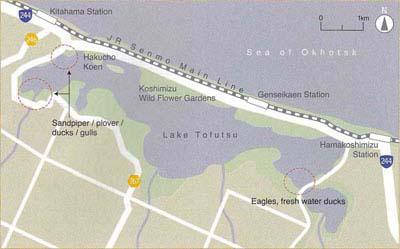 |
| Map of Tofutsu Lake (Source: Tofutsu-ko Waterfowl and Wetland Center Tofutsu-ko Guidebook, used with thanks) |
By the way, the new Tofutsu-ko Waterfowl and Wetland Center that opened in May of 2012 is worth a visit if you are birding around Tofutsu Lake. It is located in Swan Park (Hakuchou Kouen) at the west end of the lake. There are informative exhibits on the natural environment and history of the lake with texts in Japanese and Engish, as well as an extensive bulletin board with news of recent sightings and events. The staff is also extremely knowledgeable and helpful. Their website is here (mostly in Japanese at the moment).
The map at right shows these locations. There are also two parking areas along route 244 where you can stop and observe Tofutsu Lake birds.
450.jpg) |
450.jpg) |
| Japanese Cormorant (Umi-u; Phalacrocorax capillatus) in foreground with Greater Scaups (Suzu-gamo; Aythya marila) and one Common Goldeneye (Hoojiro-gamo; Bucephala clangula) (right). | Whooper Swan surrounded by Greater Scaups and a Common Goldeneye (right) who dive underwater and feed on material stirred up by the swans when they feed in the shallow waters of the lake. |
900.jpg) |
|
| Dunlins (Hamashigi; Calidris alpina sakhalina) in winter plummage. A group of 20-30 flew in at the end of the event. | |
Right: A pair of Eurasian Coots (Oo-ban; Fulica atra atra) among 11 that were in a loose group of ducks that included Gadwalls (Okayoshi-gamo; Anas strepera strepera). Below: Five of the 11 Coots. On the left is a Gadwall. Bottom: On the west side of the bridge were three more Coots and a female Mallard nearby (not in photo). |
450.jpg) |
900.jpg) |
|
900.jpg) |
|
Today's list: Tundra Bean Goose (Hishikui SSP), Whooper Swan (Oo-hakuchou), Mallard (Ma-gamo), Northern Pintail (Onaga-gamo), Greater Scaup (Suzu-gamo), Common Goldeneye (Hoojiro-gamo), Smew (Miko-aisa), Common Merganser (Kawa-aisa), Great Cormorant (Kawa-u), Japanese Cormorant (Umi-u), Grey Heron (Ao-sagi), Japanese Crane (Tanchou), Bar-tailed Godwit (Oo-sorihashi-shigi), Dunlin (Hama-shigi), Black-headed Gull (Yuri-kamome), Black-tailed Gull (Umineko), Mew Gull (Kamome), Slaty-backed Gull (Oo-seguro-kamome), Black Kite (Tobi), White-tailed Sea-Eagle (Ojiro-washi), Stellar's Sea-Eagle (Oo-washi), Peregrine Falcon (Hayabusa), Carrion Crow (Hashiboso-garasu), Large-billed Crow (Hashibuto-garasu), Brown-eared Bulbul (Hiyodori), White-cheeked Starling (Mukudori), Eurasian Tree Sparrow (Suzume), White Wagtail (Haku-sekirei), Oriental Greenfinch (Kawara-hiwa) [28 species]